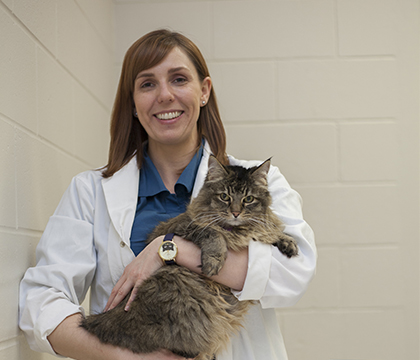
New prof builds animal nutrition program
Dr. Tammy Owens jokes that she has almost enough cats at home – seven – to run a valid feeding study, something entirely appropriate for someone who specializes in animal nutrition at the Western College of Veterinary Medicine (WCVM).
By Michael RobinOwens joined the U of S faculty as an assistant professor in the Department of Small Animal Clinical Sciences in January, recruited to add a new nutrition component to the curriculum.
Her path to veterinary medicine began in Sandpoint, a small city surrounded by woods and mountains on the shore of Idaho's largest lake, not far from the British Columbia border. A desire for a quality education and to see a bit of the country drew her to Bryn Mawr College in Pennsylvania, where she completed her undergraduate degree in biology. She worked in an immunology lab and as an EMT and considered a career in human medicine before personal circumstances drew her back across the continent to Las Vegas and a job at a veterinary clinic.
"I started pretty low on the totem pole, wrapping surgical packs," she said. "I was really putting my college degree to good use!"
But the humble job led to training as a licensed veterinary technician and a clear career path.
"I decided to be a veterinarian, which is what I wanted to be up until the point I was about 13," she said.
She crossed the country yet again to pursue her Doctor of Veterinary Medicine at Ohio State University, followed by an internship at Mississippi State University and two years working as an emergency vet at a private veterinary hospital in Tucson, Arizona. The hands-on work impressed upon her the importance of nutritional support for patients, inspiring her to complete a residency in clinical nutrition at the University of California. She continues to pursue further research there, now at a distance as she didn't want to pass up the U of S opportunity.
Owens was intrigued by the chance to build a brand-new nutrition program at the WCVM, and the promise of an academic career.
"I always knew I wanted to stay in academia, because I really like teaching and interaction with the veterinary students," she said.
Indeed, her first few months on the job have been consumed with teaching at the college veterinary clinic and creating the new curriculum on regular and therapeutic diets, that is, feeding to control conditions like kidney disease and obesity.
Owens also fields calls from practicing vets across the country on questions of animal nutrition, particularly in cats. This is where her research interest lie.
"There are just a lot of unanswered questions," she said. "Although we have a lot of ecological data in terms of what cats eat in the wild, we have very limited information in terms of what the actual nutritional composition of that diet is."
Confounding the issue is that the sunbeams-cuddles-canned food lifestyle of a family pet is far removed from the carnivorous hunt, eat-whole-prey, and reproduce life of a feral cat.
"Some pet owners do interpret ‘carnivore' as needing to feed a raw meat–based diet, but we simply don't have any evidence that such a diet is best for long-term maintenance of health in pet cats," Owens said.
"Raw diets are quite popular, and I've been contacted several times by veterinarians in different places in Canada with questions," she said. "There are definitely a lot of concerns with feeding raw diets and a lot of veterinarians feel ill-equipped to deal with that."
